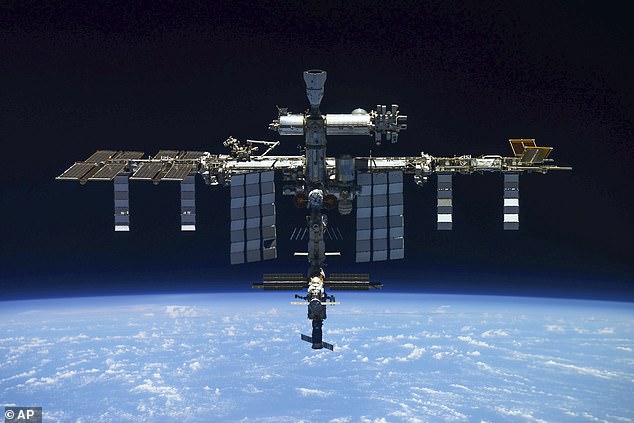Putting the STAR in Starbucks! Astronauts on board the ISS reveal plans to drink pumpkin spice cappuccinos to celebrate Thanksgiving 250 miles above Earth
>
Astronauts aboard the International Space Station may not enjoy many Earthly pleasures, but this year’s Thanksgiving menu is truly out of this world.
In honor of the 50th anniversary of Thanksgiving dinner in space, the International Space Station crew shared what they’ll be eating to celebrate the holiday this year.
The excellent menu features traditional fare such as roast turkey, cranberry sauce and apple dessert as well as some more unusual selections.
This year’s menu will also include duck, quail and seafood as well as chocolate, rice cakes and mochi.
To really put the star in Starbucks, astronauts will also enjoy a pumpkin spice cappuccino to warm them up in the cold vacuum of space.
In a video posted by NASA’s Johnson Space Center, NASA astronauts Yasmine Moghbeli and Loral O’Hara spoke alongside Andreas Mogensen of the European Space Agency and Satoshi Furukawa of the Japan Aerospace Exploration Agency.
In a video posted by NASA’s Johnson Space Center, NASA astronauts Yasmine Moghbeli and Loral O’Hara spoke alongside Andreas Mogensen of the European Space Agency and Satoshi Furukawa of the Japan Aerospace Exploration Agency.
International Space Station Commander Andreas Mogensen said: “We will celebrate Thanksgiving in space, but our thoughts are with our families at home and everyone else on Earth celebrating Thanksgiving.”
“Aboard the space station, we look forward to having a quiet day off and also a nice Thanksgiving dinner together,” Loral O’Hara added.
Ms. O’Hara then demonstrated some portions of the specially prepared dinner items for the crew.
“We have some roasted turkey, cranberry sauce, pumpkin — one of my favorites — corn, and to finish off the dessert apples,” she said.

To really put the star in Starbucks, astronauts will enjoy a pumpkin spice cappuccino to warm them up in the cold vacuum of space
While the menu may be similar, the Thanksgiving dinner enjoyed by astronauts will not look much like our dinner here on Earth.
For example, a roasted turkey is kept in a clear plastic bag.
Only the cranberry sauce maintains its familiar, earth-like appearance, and still comes in a can.
This year’s special meal was delivered to the International Space Station along with 6,500 pounds (2,948 kg) of supplies aboard an unmanned SpaceX Dragon spacecraft on November 9.
With a crew from three different countries, NASA also included some things that might not be usual at an American celebration.
In an update, NASA said crew members are “scheduled to enjoy Thanksgiving with items such as turkey, duck, quail, seafood and cranberry sauce.”
“Desserts awaiting the crew include chocolate, pumpkin spice cappuccino, rice cake, and mochi,” she added.
Some of these items may be personal requests from astronauts, with NASA saying: “Crew preferences are also taken into consideration when planning celebratory meals in space.”
On a more serious note, Ms. O’Hara added: “We also want to recognize that not everyone celebrates Thanksgiving the same way.”
“While this is a time for gratitude, it is also a time to reflect on our history and remember those who may not be able to go home for Thanksgiving or enjoy Thanksgiving dinner.”
“We hope everyone enjoys peaceful moments and spending time with their friends, families, loved ones and the planet.”
Astronaut Yasmine Moghbeli added: “This year on board the International Space Station, we are grateful for many things, one of which is our unique perspective when we look at our beautiful planet, Earth.”

The International Space Station (ISS) is a $100bn (£80bn) science and engineering laboratory orbiting 250 miles (400km) above Earth

Over the course of 50 years, Thanksgiving dinner on the International Space Station has evolved. Here Michael Hopkins (left) and Rick Mastracchio (right) show off their 2013 dinner of smoked turkey, green beans, and stuffing.
“It is a reminder to us that while everyone we know and love has returned home on Earth, we need to care for and protect them.”
This year is the 50th year that NASA astronauts have celebrated Thanksgiving in space, starting in 1973 when the Skylab crew first celebrated the holiday.
However, at that time there was no special food shipment and the crew of Gerald Carr, Edward Gibson and William Pogue still had to work a full day.
Carr, Gibson and Pogue had to skip lunch for the six-hour spacewalk and instead celebrated by eating two meals at dinner time.
The holiday was not celebrated again for another 12 years until 1985 when the International Space Station crew dined on shrimp cocktail, irradiated turkey, and cranberry sauce.
So, while this year’s crew may still be eating out of plastic bags, they certainly have a lot to be thankful for when it comes to the quality of dinner on offer.
(Tags for translation)dailymail

